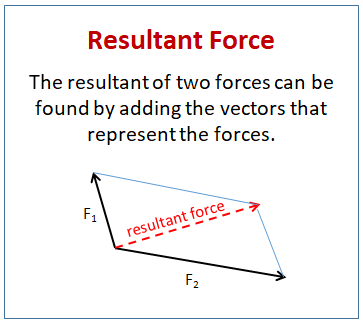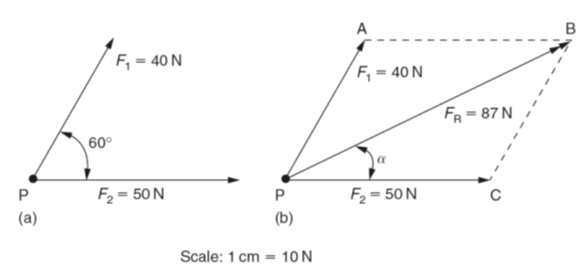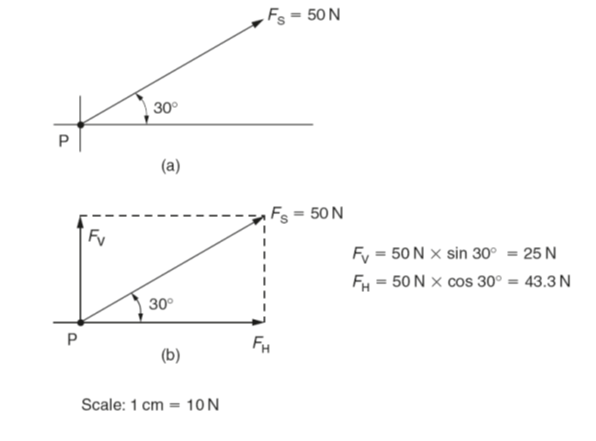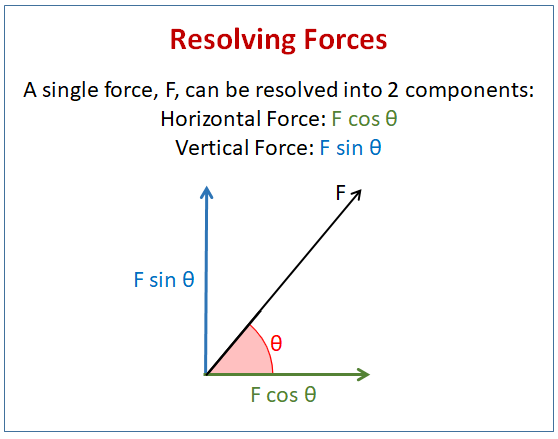How To Solve Resultant Force Vector
How to solve resultant vector using polygon method. Step 1Calculate the horizontal and vertical components of each force AB and C.

Find The Resultant Force Of The Two 3d Vectors Youtube
Two horizontal forces act on X as shown in Figure 11 A force of 55 N is applied to the right.

How to solve resultant force vector. R P 2 Q 2 2PQcos Where. Let the unknown force magnitudes be F B F C F D. To find the magnitude and angle of a resultant force we.
The formula for calculating the resultant of two vectors is. How to Resolve a Vector. The resultant force is the vector sum between the components.
Taking components of forces can be used to nd the resultant force more quicklyIn two dimensions a force can be resolved into two mutually perpendicular components whose vectorsum is equal to the given force. A 100 Kg crate as shown is supported by three cords. OverrightarrowR overrightarrowF_1 overrightarrowF_2 overrightarrowF_3 The parallelogram law triangle rule and polygon rule are geometric methods to find the force resultant.
Brought to you by. There are a two different ways to calculate the resultant vector. The parallelogram method to calculate resultant vector.
The method to nd a resultant as used in leaet 15 Force as aVector is generally slow and canbe complicated. One cord has a spring in it. Methods for calculating a Resultant Vector.
Resolving vectors into horizontal and vertical components is used in the addition and subtraction of vectors and finding the resultant of multiple vectors. Lets solve an example find the resultant of two. This video shows how to find the resultant force of two vectors using the parallelogram method.
The components are often taken to be parallel to the x- and y-axesIn two. The magnitude of the resultant force F R can be determined by measuring the length of the diagonal PB and multiplying it by the scale of the diagram 1 cm 10 N in this instance. A force of 18 N is applied at an angle of 115 degrees to the direction of the 55 N force.
Consider the force illustrated in Figure 1. Tension in cords AC and AD and the stretch of the spring. Where W weight of the box F dragging force N normal force f friction force.
The following equations shall be used to resolve any vector. We can draw the force resultant but we dont know precisely its magnitude and direction. The resultant force can be determined also for three-dimensional force systems by using the polygon rule.
An object X rests on a smooth horizontal surface. Using this force vector you can determine the forces magnitude and coordinate direction angles as needed. The resultant of two forces can be found using the methods for adding vectors when the vectors are a geometric representation.
Find magnitude of the resultant force using the new vector equation and the distance formulaDsqrtleftx_2-x_1right2lefty_2-y_1right2. We draw a parallelogram to help us find the resultant force. Add the vector equations together to get the vector equation of the resultant force.
Vectors have both magnitude and direction so it is not that easy to find the combin. When using methods for the algebraic representation to find the resultant of two forces it can be helpful to understand the components of a force. The force vector at a 400 angle can be split or resolved into two vectors or components as illustrated in Figure 2.
Use the resolution of forces to show that the magnitude of the resultant force acting on X is 65 N. When vectors represent forces their sum is called the resultant. This video discusses how to find the resultant of force vectors.
Create vector equations for each of the given forces. The resultant force FR acting at the point P is the diagonal PB of the parallelogram. The resultant vector is the vector that results from adding two or more vectors together.
1 Draw a free body diagram of Point A. Vectors have both magnitude and direction so. R Resultant of the Two Vectors P Magnitude of the First Vector Q Magnitude of the Second Vector Inclination Angle between the Two Vectors.
The head to tail method to calculate a resultant which involves lining up the head of the one vector with the tail of the other. 2 Represent each force.

How To Find Resultant Force Two Forces Mechanics Examsolutions Youtube

Resultant Of Three Forces Youtube

Magnitude And Angle Of The Resultant Force Kristakingmath Youtube

The Resultant Of Two Forces Solutions Examples Videos Worksheets Games Activities

Newton S Laws S4 Physics Revision
How To Find The Resultant Force Of Two Forces Quora

Vector Application Find Magnitude And Angle Of The Resultant Force Youtube

The Resultant Of Two Forces Solutions Examples Videos Worksheets Games Activities

Resultant Force Vector Diagrams Of Forces Graphical Solution
What Is The Resultant Force And How To Find It With Examples Phyley

How To Calculate The Resultant Force Acting On An Object X Engineer Org

How To Calculate The Resultant Force Acting On An Object X Engineer Org

Determine The Magnitude And Direction Of The Resultant Force Youtube

Difference Between Adding Force Vectors And Adding Velocity Vectors Physics Stack Exchange

Resultant Force Vector Diagrams Of Forces Graphical Solution

Finding Resultant Force From 2 Forces At 0 To 90 Degree Physics And Mathematics 90 Degrees Physics

Resultant Forces And Vector Diagrams Examples Solutions Videos Notes

How To Calculate The Resultant Force Acting On An Object X Engineer Org

Posting Komentar untuk "How To Solve Resultant Force Vector"